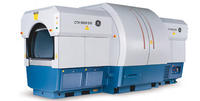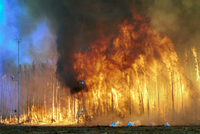-
Flir to acquire sensor maker ICx for $274 million
Flir, maker of thermal imaging technology, is acquiring ICx for $274 million; the merger will give Flir the capability to expand into the market for advanced sensors for chemical, biological, radiological, and nuclear explosives (CBRN) detection for homeland security and defense
-
-
Detecting fertilizer-based IEDs
Since 2008, IEDs have accounted for more than half of all fatalities incurred by NATO forces in Afghanistan; last year, 275 NATO soldiers died in IED attacks, and that number will likely be surpassed this year; already 228 NATO soldiers have died due to homemade bombs this year; the U.S. military continues to search for IED countermeasures
-
-
3D, interactive X-ray to offer dramatic improvement in security scans
The latest X-ray scanners can glean information about the atomic or molecular weight of a substance, and so help distinguish between materials, but the results are crude; the best they can manage is to show metal objects in one color, organic materials in another, and everything else in a third color; a new technique — called kinetic depth effect X-ray imaging, or KDEX — builds up a 3D image of the object which can be rotated and viewed from a wide range of angles
-
-
Evidence shows Turkish use of chemical weapons against Kurdish fighters
German medical experts have confirmed the authenticity of photographs showing eight dead Kurdish PKK fighters — and that the photos prove that they were killed by “chemical substances”; Turkey has been suspected for a while now of using chemical weapons against Kurdish militants, and German politicians across the political spectrum, as well as human rights organizations, have called on Turkey to explain the findings; Turkey denies the charges, calling them “PKK propaganda”
-
-
New baggage screening system from Morpho Detection evaluated

Unlike most baggage-screening systems that create two-dimensional images of objects inside luggage, the CTX 9800 DSi scanners from Morpho Detection create three-dimensional images that can be digitally manipulated by personnel when a bag is deemed to be suspicious; the machines also use advanced software to detect suspicious items; Mineta San Jose International Airport once used 28 machines to process 1,800 bags an hour, but the new system will be able to process the same number of bags using eight machines and require fewer employees to supervise the process; the technology reduces reliance on human observation and interaction with the bags; for the majority of bags, employee contact is only required when a piece of luggage is placed on or taken off the conveyor belt
-
-
100 percent air-cargo screening is going smoothly -- so far
On 1 August a law mandating 100 percent screening of cargo transported on passenger aircraft took effect; the shipping industry says that, so far, are off to a good start; experts point out that August is relatively slow shipping month, and that the real test will come in mid-September, when the busy air cargo shipping season begins
-
-
U Rochester lands $15 million to study medical response to nuclear terrorism
Research has revealed that it is not just the immediate effect of radiation that makes adults and children sick; rather, the radiation damage can remain relatively undetected in key tissues and organs, but will trigger life-threatening illnesses after an injury that occurs later; new project places the University of Rochester Medical Center firmly in a leadership position in the counterterrorism effort
-
-
Wild fires in Russia may shower region with Chernobyl-era radioactive particles

Large forested areas in Bryansk were contaminated when the Chernobyl nuclear power plant’s Reactor No. 4 exploded during a pre-dawn test on 26 April 1986, spewing radioactive clouds over much of the western Soviet Union and northern Europe; radioactive particles settled into the soil, and environmentalists have warned that they could be thrown up into the air once again by wildfires and blown into other areas by the wind; the death rate in Moscow has doubled to 700 people a day
-
-
DHS seeking unattended sensors technology for border surveillance
DHS is seeking information from companies who can build unattended ground sensors that can detect and locate people, boats, or vehicles moving along rivers, roads, and paths in dense forests; DHS says it needs this capability for border surveillance to monitor those entering the United States illegally in rough terrain
-
-
India equipped to protect the October Commonwealth Games against WMD attacks
India will have a big security challenge when the Commonwealth Games begin in October; Indian security agencies say they are equipped to face chemical, biological, radiological, and nuclear (CBRN) terrorist threats during the games; intelligence agencies have been working on the possibility of attacks from Kashmiri groups like the Hizbul Mujahidden, the Pakistan-based Lashkar-e-Taiba (LeT), the Taliban from Pakistan or Afghanistan, and even Al Qaeda; militant outfits of various other ideological hues are also on the police radar
-
-
NY Naval Militia in WMD detection homeland security exercise on Hudson River
Several New York States government agencies take part in an exercise on the Hudson River aimed to examine radiation detection capabilities; the exercise was part of Trojan Horse 2010 an annual maritime security training exercise sponsored by State University of New York Maritime College
-
-
Iraqi army trains in biological, chemical weapons removal
The Iraqi military is training in removing suspected weapons of mass destruction, including biological and chemical weapon; there are no reliable figures for the amount of unexploded ordinance located in Iraq, let alone those that may contain degraded but still dangerous substances, such as sarin nerve gas or mustard gas
-
-
Airport screening specialist Reveal Imaging acquired by SAIC
SAIC acquires Reveal Imaging Technologies of Bedford, Massachusetts; Reveal was founded in 2002 in response to the U.S. government’s mandate for aviation security screening after the attacks of 9/11. The company has developed imaging technologies for screening airport baggage and detecting explosives in checked luggage
-
-
New explosives detection technologies show promise
An adversary who is willing to die trying to carry out a mission is one of the reasons why more conventional security organizations find it so difficult to pursue their protection mission effectively in an asymmetrical war — the kind of war terrorists engage in; new explosive detection technologies may be of help
-
-
Better to teach old dogs new tricks
DHS recently announced that it wants to buy 3,000 dogs from breeders — at a cost of $4,535 per dog — to increase its force of canines who sniff out explosives, cash, and drugs; since only 20 percent of dogs who are selected for service programs successfully complete the training process, this plan will actually result in breeding 15,000 dogs, of which 12,000 will end up in shelters; one expert offers an alternative: DHS should follow the lead of the Hearing Ear Dog Program and many police departments and fill its ranks with dogs adopted from shelters
-
More headlines
The long view
What We’ve Learned from Survivors of the Atomic Bombs
Q&A with Dr. Preetha Rajaraman, New Vice Chair for the Radiation Effects Research Foundation in Hiroshima and Nagasaki, Japan.
